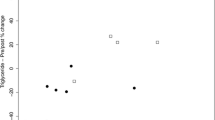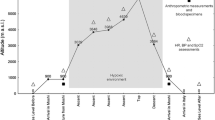Abstract
To study the influence of a 3-week hiking vacation at moderate (1700 m) and low altitude (LA) (200 m) on key-markers of the metabolic syndrome, 71 male volunteers (age 36–66 yr old) with the metabolic syndrome [according to the National Cholesterol Education Program’s Adult Treatment Panel III (NCEP-ATP III) — or World Health Organization (WHO) — definition] participated in the study and were randomly assigned into a moderate altitude (MA) group (1700 m, no. 36) and a low altitude (LA) group (200 m, no. 35). The 3-week vacation program included 12 moderate-intensity guided hiking tours [4 times/week, 55–65% heart rate maximum (HRmax)] with a total exercise time of 29 h plus moderate recreational activities. Both study groups had a comparable and balanced nutrition with no specific dietary restrictions. Anthropometric, metabolic and cardiovascular parameters were measured 10–14 days before vacation, several times during the 3-week vacation, 7–10 days and 6–8 weeks after return. All participants tolerated the vacation without any adverse effects. Body weight, body fat, waist-circumference, fasting glucose, total cholesterol, LDL-cholesterol (LDL-C), plasma fibrinogen, resting systolic and diastolic blood pressure were significantly decreased over time in both study groups. In the LA group, fasting insulin and homeostasis model assessment (HOMA)-index were significantly decreased one week after return. Relative cycle ergometry performance was significantly increased after return compared to baseline. In both study groups, waist-to-hip ratio (WHR), 2-h oral glucose tolerance test (OGTT), HDL-cholesterol (HDL-C), and triglycerides remained unchanged. The 3-week vacation intervention at moderate and LA had a positive influence on all key-markers of the metabolic syndrome. No clinically relevant differences could be detected between the study groups. A hiking vacation at moderate and LA can be recommended for people with stable, controlled metabolic and cardiovascular risk factors.
Similar content being viewed by others
References
Lakka HM, Laaksonen DE, Lakka TA, et al. The metabolic syndrome and total and cardiovascular disease mortality in middle-aged men. JAMA 2002, 288: 2709–16.
National Cholesterol Education Program. Executive Summary of The Third Report of The (NCEP) Expert Panel on Detection, Evaluation, And Treatment of High Blood Cholesterol In Adults (Adult Treatment Panel III). JAMA 2001, 285: 2486–97.
Grundy SM. Primary prevention of coronary heart disease: integrating risk assessment with intervention. Circulation 1999, 100: 988–98.
Tuomilehto J, Lindstrom J, Eriksson JG, et al. Prevention of type 2 diabetes mellitus by changes in lifestyle among subjects with impaired glucose tolerance. N Engl J Med 2001, 344: 1343–50.
Gump BB, Matthews KA. Are vacations good for your health? The 9-year mortality experience after the multiple risk factor intervention trial. Psychosom Med 2000, 62: 608–12.
Burtscher M. High altitude headache: epidemiology, pathophysiology, therapy and prophylaxis. Wien Klin Wochenschr 1999, 111: 830–6.
Friedewald VE, Jr, Spence DW. Sudden cardiac death associated with exercise: the risk-benefit issue. Am J Cardiol 1990, 66: 183–8.
Billman GE. Aerobic exercise conditioning: a nonpharmacological antiarrhythmic intervention. J Appl Physiol 2002, 92: 446–54.
Burtscher M, Philadelphy M, Likar R. Sudden cardiac death during mountain hiking and downhill skiing. N Engl J Med 1993, 329: 1738–9.
Schobersberger W, Schmid P, Lechleitner M, et al. Austrian Moderate Altitude Study 2000 (AMAS 2000). The effects of moderate altitude (1,700 m) on cardiovascular and metabolic variables in patients with metabolic syndrome. Eur J Appl Physiol 2003, 88: 506–14.
Gunga HC, Fries D, Humpeler E, et al. Austrian Moderate Altitude Study (AMAS 2000) — fluid shifts, erythropoiesis, and angiogenesis in patients with metabolic syndrome at moderate altitude (congruent with 1700 m). Eur J Appl Physiol 2003, 88: 497–505.
World Health Organisation. Definition, diagnosis, and classification of diabetes mellitus and its complications: report of a WHO consultation. Part 1: diagnosis and classification of diabetes mellitus. Geneva, Switzerland: World Health Organisation 1999.
Kushner RF, Schoeller DA. Estimation of total body water by bioelectrical impedance analysis. Am J Clin Nutr 1986, 44: 417–24.
Joint National Committee. The sixth report of the on prevention, detection, evaluation, and treatment of high blood pressure. Arch Intern Med 1997, 157: 2413–46.
Matthews DR, Hosker JP, Rudenski AS, et al. Homeostasis model assessment: insulin resistance and beta-cell function from fasting plasma glucose and insulin concentrations in man. Diabetologia 1985, 28: 412–9.
Wei M, Kampert JB, Barlow CE, et al. Relationship between low cardiorespiratory fitness and mortality in normal-weight, overweight, and obese men. JAMA 1999, 282: 1547–53.
Laukkanen JA, Lakka TA, Rauramaa R, et al. Cardiovascular fitness as a predictor of mortality in men. Arch Intern Med 2001, 161: 825–31.
Fagard RH. Exercise characteristics and the blood pressure response to dynamic physical training. Med Sci Sports Exerc 2001, 33: S484–92.
Bacon SL, Sherwood A, Hinderliter A, Blumenthal JA. Effects of exercise, diet and weight loss on high blood pressure. Sports Med 2004, 34: 307–16.
Pouliot MC, Despres JP, Lemieux S, et al. Waist circumference and abdominal sagittal diameter: best simple anthropometric indexes of abdominal visceral adipose tissue accumulation and related cardiovascular risk in men and women. Am J Cardiol 1994, 73: 460–8.
Bjorntorp P. Hormonal regulation of visceral adipose tissue. Growth Horm IGF Res 1998, 8(Suppl B): 15–7.
Azevedo JL Jr, Carey JO, Pories WJ, Morris PG, Dohm GL. Hypoxia stimulates glucose transport in insulin-resistant human skeletal muscle. Diabetes 1995, 44: 695–8.
Khayat ZA, Patel N, Klip A. Exercise- and insulin-stimulated muscle glucose transport: distinct mechanisms of regulation. Can J Appl Physiol 2002, 27: 129–51.
Larsen JJ, Hansen JM, Olsen NV, Galbo H, Dela F. The effect of altitude hypoxia on glucose homeostasis in men. J Physiol 1997, 504: 241–9.
Ivy JL. Role of exercise training in the prevention and treatment of insulin resistance and non-insulin-dependent diabetes mellitus. Sports Med 1997, 24: 321–36.
Grundy SM. Hypertriglyceridemia, atherogenic dyslipidemia, and the metabolic syndrome. Am J Cardiol 1998, 81: 18B-25B.
Carroll S, Dudfield M. What is therelationship between exercise and metabolic abnormalities? A review of the metabolic syndrome. Sports Med 2004, 34: 371–418.
Ernst E, Koenig W. Fibrinogen and cardiovascular risk. Vasc Med 1997, 2: 115–25.
Koenig W. Haemostatic risk factors for cardiovascular diseases. Eur Heart J 1998, 19(Suppl C): C39–C43.
Imhof A, Koenig W. Exercise and thrombosis. Cardiol Clin 2001, 19: 389–400.
Author information
Authors and Affiliations
Corresponding author
Rights and permissions
About this article
Cite this article
Greie, S., Humpeler, E., Gunga, H.C. et al. Improvement of metabolic syndrome markers through altitude specific hiking vacations. J Endocrinol Invest 29, 497–504 (2006). https://doi.org/10.1007/BF03344138
Accepted:
Published:
Issue Date:
DOI: https://doi.org/10.1007/BF03344138




